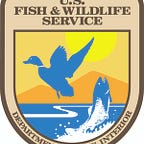Spawned Salmon Touch Many People, Places Throughout Pacific Northwest
By Brent Lawrence, a Public Affairs Officer for the U.S. Fish and Wildlife Service’s Columbia Pacific Northwest Region.
The impact of the U.S. Fish and Wildlife Service’s National Fish Hatcheries in the Pacific Northwest is far reaching.
Consider how the spawning efforts at a single hatchery can positively touch so many people.
Carson National Fish Hatchery, for example, recently completed its spawning of spring Chinook salmon for the year. Located on the Wind River in the Columbia River Gorge, the hatchery spawned 720 female salmon, which accounts for about 2.6 million eggs.
The impact of those fish will extend far beyond the Wind River, as the salmon eggs will be used to support a variety of efforts and people across the Pacific Northwest. Salmon are culturally significant to multiple Tribes, representing the symbol and lifeblood of many Tribes who call the Pacific Northwest home. Salmon also are a critical part of the economy in the Pacific Northwest through recreational and commercial fishing, and the Service’s hatchery programs play a role in addressing Columbia River Basin hydropower operations.
About 2,740 adult spring Chinook salmon returned to Carson NFH this year. Of the fish that returned, the Service provided 508 early-arriving surplus salmon to Tribes for ceremonial and subsistence programs.
“We had a great return of spring Chinook this year, and the total number of fish exceeded our expectations,” said Larry Zeigenfuss, hatchery manager at Carson National Fish Hatchery. “The last three years we’ve had an average of 804 salmon return, so this was a pleasant surprise. As a result of having so many salmon come back, we were able to work with our Tribal partners to provide them a significant number of salmon for use in ceremonial and subsistence programs.”
But the Tribal partnership doesn’t stop there. About 360,000 eggs from 120 female salmon have been transferred to the Confederated Tribes of the Umatilla Indian Reservation to assist them with their Walla Walla Production Program. They were transferred as unfertilized eggs (roe) before being mixed with sperm (milt) for fertilization.
That leaves about 2.2 million eggs from the other 600 female salmon. Of those, 1.7 million eggs will be incubated in the fish nursery at Carson NFH.
About 1.52 million smolts (a young salmon after the parr stage, when it becomes silvery and migrates to the sea for the first time) will be reared and eventually released into the Wind River. Most of those (1.42 million) are to meet Mitchell Act commitments. The other 100,000 are a recent increase designed to support the southern resident killer whale program.
Another 250,000 eyed-eggs will be provided to initiate a spring Chinook harvest mitigation program in the Touchet River as part of the Lower Snake River Compensation Plan. An eyed-egg is a fish egg containing an embryo that has developed enough so the black spot of the eyes are visible through the egg membrane. Once they have eyed-up, the egg is less sensitive to movement and can be safely transported.
That leaves a few extra eggs. The extra eggs are collected in case some need to be culled due to bacterial kidney disease. During good years when bacterial kidney disease is low, the extra eggs are not needed and are offered to Tribes or state hatcheries. They can use those surplus eggs if their number of returning salmon is lower than expected.
Several hundred eggs are also devoted to education each year. The Salmon in the Classroom program places a salmon tank in classrooms allowing students to observe development of the salmon from eyed egg to fry. More than 33 schools in the Columbia River Gorge and a handful in Portland schools benefit from this program run by the Columbia River Gorge Information and Education Office.
In addition to receiving eggs to rear and observe, the students get three personalized lessons that cover watershed health, adaptations and importance of habitat and a salmon dissection. Students begin the unit with a hatchery visit to understand the important role of hatcheries in the current situation of the Columbia and salmon populations; the unit culminates with releasing their salmon fry into the river.
The salmon spawned in August 2021 will spend about 18 months at Carson NFH or other locations before being released in April 2023. From there they’ll begin their journey out to the Pacific Ocean.
“Our staff did a great job with the spawning this year, and we’ll work hard to care for them over the next 18 months to create the next generation of these amazing fish,” Zeigenfuss said. “We’ll also provide support to our sister hatcheries in the Columbia River Gorge National Fish Hatchery Complex because there’s a lot more spawning ahead of them this fall.”
